Behavioral Response Study (BRS-07) on Andros Island, Bahamas
The Study
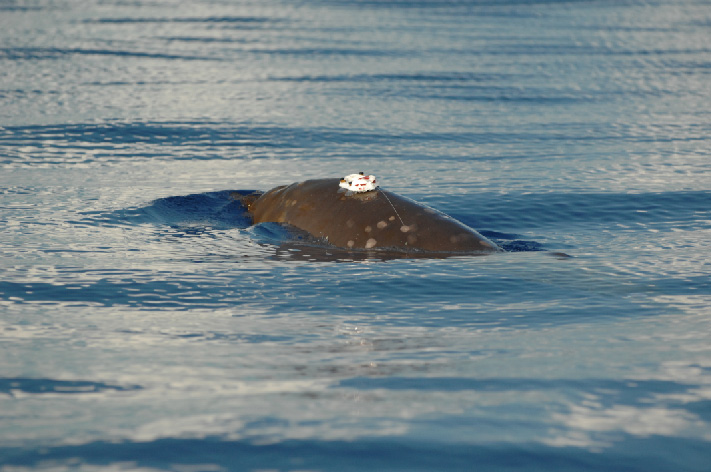 Blainville's Beaked Whale, tagged (Mesoplodon densirostris) Photo: Ari Friedlaender, Duke University |
Marine Mammals and Underwater Sound
Increasing evidence suggests that exposure to intense underwater sound in some settings may cause certain marine mammals to strand and ultimately die. Some of these strandings are associated with mid-frequency active (MFA) military sonars and most have involved beaked whales; the dominant species is Cuvier's beaked whale (Ziphius cavirostris), but the genus (Mesoplodon) has also been involved. The coincidence between certain atypical mass strandings and active sonar exercises is convincing, but insufficient information is available to assess whether other signals pose a similar risk and whether other species may also be at risk. Until the causes of these strandings can be identified, and possibly dose : response relationships defined, it will remain difficult to discriminate an actual hazard from random coincidences of human activities and natural strandings.
One of the most direct and precise ways to test whether certain sounds could pose a risk of inducing strandings is to conduct behavioral response studies (BRS) composed of both observational studies and carefully controlled experiments to determine safe and early indicators of responses that may be linked to a causal chain of events leading to stranding. This type of field research has been repeatedly identified by the National Research Council (1994, 2000, 2003, 2005) as a critical data need and was specifically identified as the foremost data need regarding beaked whales and sonars at a U.S. Marine Mammal Commission symposium on beaked whales (Cox et al., 2006).
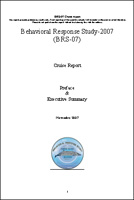 BRS-07 Phase I Report [pdf] |
BRS Phases
A multi-phase field research project is underway to conduct BRSs of various underwater sounds to marine mammals (including beaked whales and other odontocetes). The overall goal of both phases is to understand the initial steps in the chain of events that lead from sound exposure to atypical mass strandings of beaked whales; and to use that understanding to identify a safe response that can be used to indicate risk. The exposures are and will be carefully controlled and measured on the subjects using sophisticated acoustic tags to make it possible to titrate what acoustic exposure leads to an indicator response. The movements and acoustic behavior of the subject are also being monitored in realtime with a passive hydrophone array.
The goal of Phase I was to determine the acoustic exposures of MFA sonar sounds that elicit an identifiable and safe behavioral response in beaked whales and pilot whales. The outcomes and results of Phase I (November 2007) [pdf] are available.
The goals of and planning for Phase II (2008) are being developed based on the Phase I results, but are expected to include larger, more representative signals of several types.
Researchers: Principle Investigator, Chief Scientist, and Co-Investigators
Brandon Southall (NOAA's Ocean Acoustics Program) is the Principal Investigator and Ian Boyd (Sea Mammal Research Unit, University of St. Andrews, Scotland) is the Chief Scientist. Co-investigators include Christopher Clark (Cornell University), Peter Tyack (Woods Hole Oceanographic Institution), Darlene Ketten (Woods Hole Oceanographic Institution), and Diane Claridge, Bahamas Marine Mammal Research Organization.
Previous Documentation and the BRS-07 Planning Phase
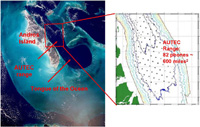 Map of Andros Island, Bahamas, with the AUTEC range and Tongue of the Ocean highlighted Photo: GoogleEarth/NOAA (page 5 in the report) |
Scope
This document describes the rationale and background for a Behavioral Response Study (BRS-07) planned for the period August-September 2007 at the Atlantic Undersea Test and Evaluation Center (AUTEC) on Andros Island, Bahamas.
The study is a response to increasing evidence suggesting that exposure to intense underwater sound may cause certain marine mammal species to strand, and in some situations the stranded animals die. A small percentage of reported marine mammal strandings have been associated in time and space with mid-frequency active (MFA) military sonar transmissions and the study will focus upon the effects of MFA sonar on some of the same species that have previously stranded. As such, this study is intended to provide some direct, empirical information on a matter of pressing concern and practical importance to the navies, regulatory agencies, scientists, environmental groups, and other concerned parties in many nations. The study is a first step toward developing the methods that we require to analyze the effects of sound on beaked whales and other cetacean species. The intention is that this study will be followed by others, but the exact form of these will be contingent on the outcome of the current field research (BRS-07). While the early results from the BRS studies must be interpreted with substantial caution for many methodological reasons, the results obtained in the overall BRS effort are expected to significantly enhance the scientific basis for reducing risk of harm to marine mammals from MFA and to help regulators and those involved in generating underwater sounds to assess and predict the risks to cetaceans from activities involving MFA sources.
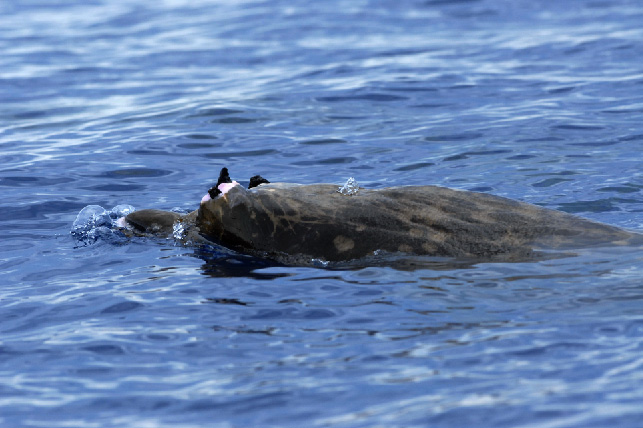 Blainville's Beaked Whale (Mesoplodon densirostris) Photo: Ari Friedlaender, Duke University |
Background
Beaked whales are very challenging animals to study. They dive for long periods of time (>40 min) and they are some of the deepest divers of the cetaceans, reaching depths of over 2,000 m (6,562 ft). Studying these species using casual, surface-based observations yields little data that can inform us about their responses to specific types of sound. It is for this reason that we have chosen to conduct a study under circumstances, and with instruments, that will give us the greatest possible opportunity to collect sufficient data, and with a sufficient sample size, to begin to draw some statistically valid conclusions about the effects of MFA sonars.
The study is designed to allow us to control as many of the variables as possible while keeping the context as natural as possible. Combining this with a need for extreme precaution in our approach at these early stages--because we really do not know how the animals will react--we have chosen a research protocol that balances the need for scientific rigor with practicality and also the need to ensure the welfare of the animals involved.
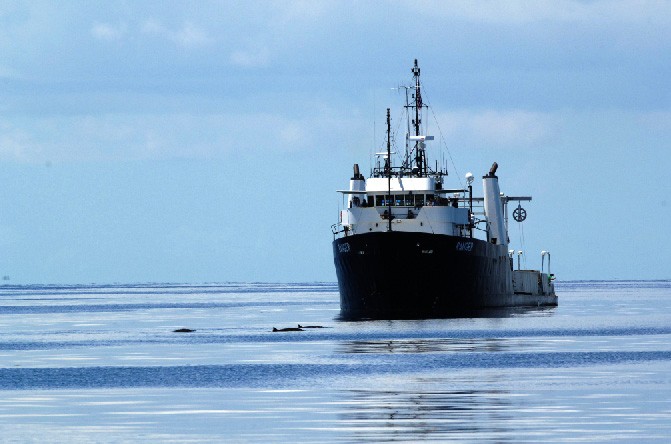 BRS-07 Research Vessel Photo: Ari Friedlaender, Duke University |
Metrics and Protocols
This is truly a balance between intentions to not harm experimental subjects and to obtain critically-needed empirical data as rapidly as possible in challenging experimental conditions. Consequently, our approach throughout will be precautionary and adaptive in the sense that we will start by being very sensitive to behaviors that could potentially be interpreted as responses to MFA. Then as we build experience with how the animals react, or don't react, under each circumstance we will gradually change the experimental conditions to investigate the point at which behavioral responses occur. This kind of adaptive approach, which is generally common in conditions where potentially harmful effects are being investigated and relatively little is known, is being applied to individual exposures within the context of the BRS being undertaken at AUTEC in 2007, as well as on a broader scale. For example, in 2007 we will be using a lower power MFA sound source (deployed from a research vessel) in an area where whales are likely to have been habituated to these sounds to some extent, but on an acoustic range where sophisticated listening technologies can be employed in locating and tracking animals. In 2008, the working plan would be to use actual MFA sound source (e.g., actual MFA source platforms) probably again in an area where animals are likely to have been habituated. In 2009, the proposal would then be to test animals in an area where they had most likely had limited or no exposure to these sound sources. At each stage in this process the plan will be modified depending upon the results from the latest studies and bearing in mind both animal welfare considerations and scientific progress. Currently, the concept is that we will ramp up the intensity of exposure over time to a point where there are measurable behavioral reactions that could be used to indicate a biologically significant response. At no stage in this experiment is there any intent to create conditions in which animals are in danger of harmful exposures or stranding. Behavioral indicators are being used as a precautionary metric of possible responses that could lead to such situations.
The study will initially be carried out at AUTEC. This site for BRS-07 was chosen from a list of many other candidate sites using a set of requirements, and AUTEC was deemed most suitable for BRS-07. Criteria used to assess the suitability of candidate sites included local logistics, weather conditions, accessibility, permitting processes, density of beaked whales and other species, likely exposure history of animals, background acoustic environment and overall likelihood of success. AUTEC has particular advantages because it has an array of many hydrophones deployed on the seabed within deep water where beaked whales are known to occur. Beaked whales can be detected and localized using the hydrophone array thus helping the research team to locate whales quickly. Moreover, data from the hydrophones provide important information about both the sound source being used and the reactions of the whales.
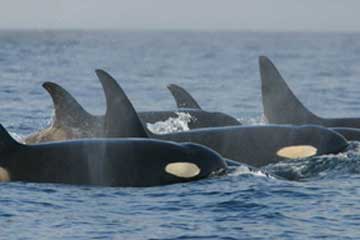 Killer Whales (Orcinus orca) Photo: NOAA |
The protocol for the initial phase of these experiments (i.e., BRS-07) involves the use of a sound source suspended in the water to a depth of about 50 meters (164 ft). This source will be used to transmit signals similar in form to those produced by MFA sonars. It will also be used to transmit white noise and killer whale (Orcinus orca) calls. Killer whale calls are being used to test the hypothesis that the responses to MFA are similar to those produced in response to a natural predator. Beaked whales will be exposed to received levels of between 80 and 160 dB (re 1 µPa rms) which is well below thresholds that could even cause temporary hearing loss, much less direct physical trauma. The sound levels will be ramped up from a low level during the course of a dive made by an animal. Premature cessation of vocal activity, measured on a number of passive listening systems, will be used as the point at which a behavioral effect has been observed. Moreover, animals will be observed when at the surface and indications of abnormal behavior will lead to termination of that particular exposure. Visual observations of animals while they are at or near the surface are also an important part of the experimental protocol.
Assuming that the behavior of the animal is not abnormally affected, each focal animal will be exposed to a series of sounds during successive dives. The exposures will include positive (white noise) and negative (no sound) controls, MFA sonar sound and killer whale calls. The exposure pattern will be similar for all of these sound types and the measurement of response will be identical, but the order in which sounds are played to the animals will vary between experiments.
It is essential that we are able to measure the actual sound received by a whale and its detailed behavioral response. To achieve this, each focal animal will have a non-invasive digital archival tag (DTAG) attached to the skin with suction cups. The number of opportunities to attach tags will determine the number of experiments carried out whereas the duration of tag attachment with determine the number of exposures experienced by each tagged animal. Normally, tags will not remain attached for more than 12-18 hours so we do not expect to obtain more than 3 acoustic exposures per tagged animal. On average, it may take up to a week of effort to tag a single beaked whale, so we hope to achieve a minimum sample size of 6 individual beaked whales during the course of the study.
Data from tags and other observations will be analysed between each experiment to learn as much as possible about the responses of animals before undertaking the next experiment. This is part of the adaptive approach being taken. It is also possible that other deep-diving cetacean species (e.g., pilot whales, sperm whales) will be tagged if beaked whales are not available.
Permits and Precautions
The study will be carried out under permits and authorizations issued by the Bahamian Government as well as the United States Government. As a precautionary measure, a stranding response and communications plan has been developed and the study will be accompanied by aerial surveys to check for strandings in the region. The field research is being conducted by a diverse and experienced team of scientists that is led by a number of globally-recognized marine biologists and bio-acousticians with responsibility for each component of the study--tagging, visual observation, passive acoustic monitoring, focal follows, acoustic propagation modeling, and data collation and analysis. It will be coordinated in the field by a Chief Scientist who will have oversight of all activities and who will be responsible for making decisions in response to changing situations during the course of the study and communicating those decisions to the Principal Investigator.
Links
Phase I Report [pdf]
Press Release: Speak with Scientists [pdf]
BRS Permitting Information and Documents
Photos - Woods Hole Oceanographic Institution (WHOI) ![]()
More Information about Beaked Whales